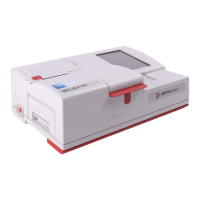Operator’s Manual – OPTI CCA-TS2 Cl-1
ANALYTES CHLORIDE
Chloride (Cl
-
)
Clinical Signicance
1
Chloride is an anion that exists predomininantly in extracellular spaces. It maintains cellular integrity
through its inuence on osmotic pressure. It is also signicant in monitoring acid-base balance and water
balance. In metabolic acidosis, there is a reciprocal rise in chloride concentration when the bicarbonate
concentration drops.
Decreased levels are found in severe vomiting, severe diarrhea, ulcerative colitis, pyloric obstruction,
severe burns, heat exhaustion, diabetic acidosis, Addison’s disease, fever and acute infections such as
pneumonia.
Increased levels are found in dehydration, Cushing’s syndrome, hyperventilation, eclampsia, anemia and
cardiac decompensation.
Measurement Principle
The Cl
-
ion optodes are closely related to the more familiar Ion Selective Electrodes (ISEs).
The optodes use ion selective recognition elements (ionophores) similar to those used in ISEs, however
the ionophores are linked to uorescent dyes instead of electrodes. These types of dyes have been
used since the 1970’s to visualize and quantify cellular ion levels in uorescence microscopy and cell
counters
2
. As the ion concentration increases, these ionophores bind larger amounts of ions and cause the
uorescence intensity to increase or decrease, depending on the particular ion. Like the pH optode, the
ion optodes do not need a reference electrode, however, several of them do exhibit a small pH sensitivity
which is automatically compensated in the OPTI CCA-TS2 using the measured pH.
Measurement Range
Range Resolution (Low/High) Units
50 to 160 1/0.1 mmol/L
Standard Reference Cassette (SRC) Limit Values
LOW NORMAL HIGH Units
80.0 ± 2 105.0 ± 2 130.0 ± 2 mmol/L

